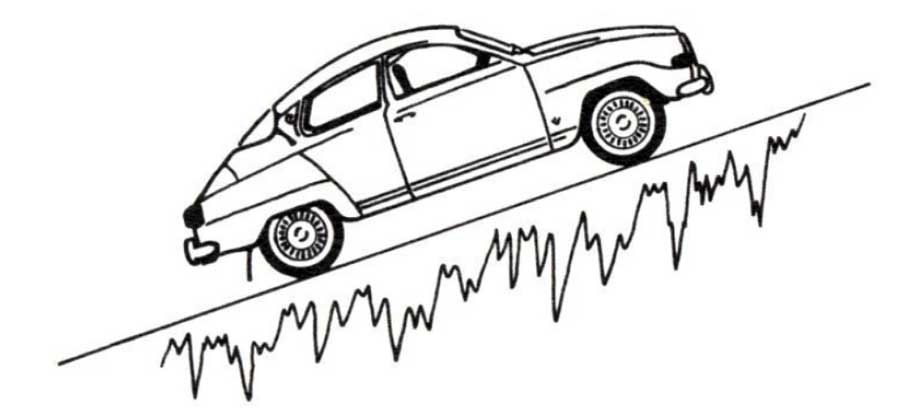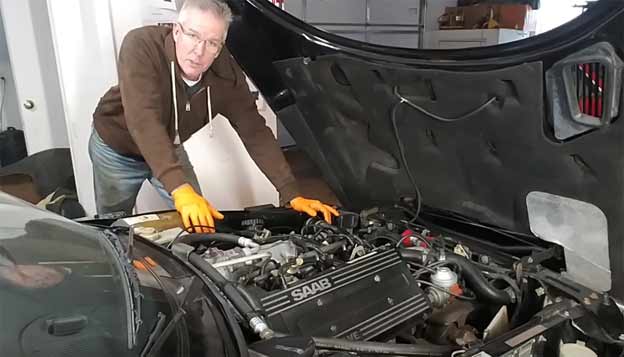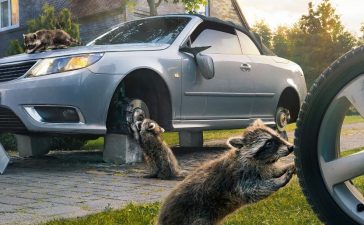By the early 1920s, when it was technically possible to build a practical front drive car, automotive design was, in general, so frozen that there was little interest in any radical departure from front mounted engines driving rear wheels. Therefore, the first practical front drive cars came not from the big prosperous manufacturers but from the specialized field of racing. The sleek and exciting looking Front Drive Miller Specials rocketed to success at Indianapolis, virtually made “front wheel drive” a household phrase and instilled in the heart of half America the burning desire to own a “Front Drive”.
In the 1920s, many small automakers tried to create a functioning front-wheel drive car, but many of them encountered many problems. About 1929 the Auburn company in the USA built the first front drive Cord, based largely upon the Miller design. Then came the Ruxton, a better design in some ways, but destined for early failure just as the depression hit after only a few hundred cars had left the midwestern factory. Unfortunately, all these 1925·30 designs suffered seriously from wheelspin on acceleration and on hills due to insufficient weight on the driving wheels.
By the early 1930s there was quite a notable list of front drive cars in production. In addition to those already mentioned there were DKW, Adler and Audi in Germany, the Steyr in Austria, BSA in England and a number of experimental designs in France such as the V16 Bucialli. The DKW which went into volume production in 1932 earned a couple of “firsts” in front wheel drive history.

Table of Contents
ADVANTAGES OF FRONT WHEEL DRIVE
by Rober Barlow
The author Roger Barlow is a noted automotive and outdoor writer whose articles have appeared in Road Be Track, The Autocar, Motor Trend, Motor Sports World, Field Be Stream, Competition Press, etc. This article, in longer form, was originally published in The Sports Car Journal.
The present examples of front wheel drive are all outstandingly safe, comfortable, practical and above all interesting motor cars with virtually no vices and with much, indeed, to recommend them to the average family. Let me enumerate some of the clear and evident advantages of FWD in the hands of normal motorists.
Steering
About this part of the performance and character of a motor car it is impossible to be too critical. It is also the least satisfactory aspect of an incredible number of vehicles ranging from Detroit monsters to European midgets. I have never driven a front drive car which failed to go down the road as if on rails and I have rarely driven a conventional car (American of foreign) with this feeling. Most cars seem to need continuous correction. The front drive is merely pointed at the horizon and then steered only when you want to turn it. You don’t twiddle the wheel continuously just to stay on your own side of the highway! The old pre-war Citroens and Cords gave front drive cars the reputation of being somewhat heavy steering at low speeds and when parking but the new breed of FWD cars such as SAAB, Lancia, DKW and some others are not only very light steering but actually turn sharper than many conventional cars-and without power assistance. The type of constant velocity universal joints now found on most FWD cars not only permit these remarkably tight turning circles but have eliminated any trace of steering reaction even when full power is applied in low gear. The superb sense of control given by the steering of virtually all FWD cars must be experienced to be appreciated. On this point the FWD car cannot be excelled and is rarely equalled.
Roadholding
In their ability to negotiate either slow or fast bends with the absolute minimum of roll, tire squeal and unwanted deviation from an established line, FWD sedans are pretty much in a class by themselves. The excess of weight in the tail of the rear-engined car results in extreme over-steer characteristics when cornering (the tendency to go backwards through the fence on the other side of the road) while the present-day conventional car with a big engine in front driving through the rear wheels suffers from under-steer when cornering hard (the tendency to go head-on through that fence on the other side of the road). All modern front drive cars I have driven seem devoid of either excessive over or under-steer. They simply go where pointed, and without argument!
When near the limit of adhesion in a fast corner, a slight bump or spot of oil will usually send both rear engined and conventional sedans into really hard-to-control skids, but the FWD car seem virtually unaffected under such circumstances as the pull of the front wheels in the direction of the bend quickly restores directional stability even if momentarily jolted off the chosen line. On wet roads, and especially when crossing and recrossing street car tracks, the FWD sedan shows its unequalled surefootedness. One can take a modern FWD sedan, such as a SAAB, and zig-zag it across wet car tracks under fun throttle in the gears, the wheels spinning wildly half the time, without the slightest inclination for it to do anything other than to go where you want it. Icy hills, where the slightest bit of rear wheelspin sends cars into the ditch, will often be climbed by a FWD car with the front wheels spinning for, even then, steerability is not lost.
In terms of normal family sedans driven by ordinary drivers, there is a very considerable safety factor favoring the FWD design. It does not misbehave and frighten the driver upon entering an unexpected sharp turn at a somewhat higher rate of speed than intended. It can be taken through bends at high speeds by no more than simply steering it, whereas in a conventional car (and to an even greater degree in a rear-engined one) the driver negotiating the same bend at the same speed would have to be doing a job of correcting slides and using judgement and skill which the average motorist or his wife simply does not have. When roads are covered with snow or ice this goes double, and in spades!
Reliability
There seems to be a long standing belief that front wheel drive automatically entails considerably more complication than conventional or rear engined designs. Not so. The modern FWD car is unquestionably as trouble-free and long lived as any others. There is certainly no need to be concerned over the U-joints for they seem to have almost unlimited life_ (One of my present FWD cars has nearly 80,000 hard miles on its speedo and yet the entire drive line seems as tight as when new). Universal joints are used, it should be remembered, on all cars; front wheel drives merely use an extra pair. In several hundred thousands of miles of front wheel driving with a variety of cars I have never found it necessary to carry out repairs to the front drive mechanism of any of them.
Comfort and Room
The small FWD sedan seems to have a somewhat better ride than most conventional cars of the same size largely because of the elimination of the considerable unsprung weight of the heavy rear axle unit. Another contribution to comfort is the low build of the FWD sedan which permits softer suspension without introducing excessive roll when cornering. As the space at the rear of a motor car is more suitably shaped to accept a variety of luggage than is the space between the front wheels, the FWD sedan has a far more useful trunk than has a rearengined car. It is usually better than that of a conventional sedan of the same general size because the FWD car needs less space for its simple light rear axle tube or independently sprung rear wheels.
And because there is no drive shaft or gearshift tunnel going back through the center of the body, the FWD sedan offers the best and most useful interior space for the seating of passengers. An unobstructed flat floor makes it possible to enter and exit the car with greater convenience and permits a more comfortable seat height than is found in many other types. The many practical benefits of front wheel drive design have finally become evident to numerous manufacturers in recent years. Possibly the most surprising automotive development was the adoption of front wheel drive by Lancia. This famous old Italian firm has made a fetish of superior roadholding and steering for half a century and yet they reached the conclusion that they had made all the progress possible in this aspect of design with driven rear wheels. Having piloted their new FWD Flavia up and down a couple of Alps it is clearly evident to me that with their new approach they have not only set new standards in cornering and stabiljty for family cars, even for Lancia, but have also secured an exceptionally comfortable and quiet ride under all conditions.
SAAB cars and FWD
While some manufacturers have changed ·from conventional layouts to front wheel drive there are others, like the Swedish jet aircraft builder, who decided right Jeom the start that the best engineering approach to making a practical, high performance, compact family sedan was to utilize front wheel drive. Thus all SAABs have been of this design. The combination of 2-stroke engine and front wheel drive was not only eminently suitable for the graveled roads and severe winter conditions of Sweden but quickly gained success throughout Europe and in our own New England states, where they were first mtroduced when SAAB decided to enter the US market with their cars.
What started out as a simple, safe, solid and practical family sedan turned out to be so solid and rugged, so safe under all road conditions, no matter how hazardous, and so thoroughly practical that sports car type drivers began to run the SAABs in many of the most difficult and demanding rallies in both Europe and America. At first these SAAB drivers were content to merely defeat cars in their own class, but success begats success and so it was inevitable that SAAB would eventually defeat all competitors, regardless of engine size; in 1962 they did this by winning outright the greatest of all rallies, the formidable Rallye De Monte Carlo. Then just to prove it was no accident, SAAB won the “Monte” outright again the following year!
Now SAABs specially equipped version of that safe and practical FWD family sedan have proudly borne the name “MONTE CARLO” and I wonder if maybe SAABs sbouldn’t be required to display a large sign on their shapely backside warning other drivers to, “FOLLOW AT YOUR OWN RISK … THIS IS A FRONT WHEEL DRIVE CAR”!
But in all seriousness, your life, and the lives of others riding with you, may some day depend directly upon the accuracy and responsiveness of your cars steering, upon the effectiveness of its roadholding and upon its resistance ,to skidding in some sudden emergency-it is in these most vital characteristics that the front wheel drive car excells. For these reasons alone it deserves our most serious and intelligent consideration when selecting a new family car.
written by Roger Barlow
AWD vs. FWD vs. RWD Explained
FWD has enough trouble getting the power down with all the weight over the wheels, once you remove that weight I wouldn’t think it would be such a pleasant experience. It also goes against the whole principle of an FWD car which is to be lighter and less complicated than an AWD or RWD car. Having a rear engined FWD car would be just as complex and heavier as a RWD setup…

‘Prefer?’ is a difficult question. They can both kick ass. Arguably, these days front wheel drive technology allows really serious performance for those on a real-world budget, rear wheel drive generally being found in more expensive cars. But it isn’t the compromise it once may have been. And most people with rear wheel drive cars, A: don’t take them on track, and, B: don’t drift them around roundabouts on public roads, so it’s advantages are rarely exploited. Rear wheel drive will still give the purist, most engaging overall drive. But it’s not the easy decision it was in years past.
When the going gels rough _ on rain-slick roads, on snow or ice, in mud or sand – SAAB fronl wheel drive gives you complete control. Sensitive, surefooted sports car handling makes SAAB the family sedan for car enthusiasts. It’s all there, at your fingertips : the feel of the engine bearing down with all Its weight on the driving wheels, easing you in and out of turns. Gone are the slides, the skids, the spinouts. SAAB goes exactly where you aim it, gives you a sixth-sense road-sense.











